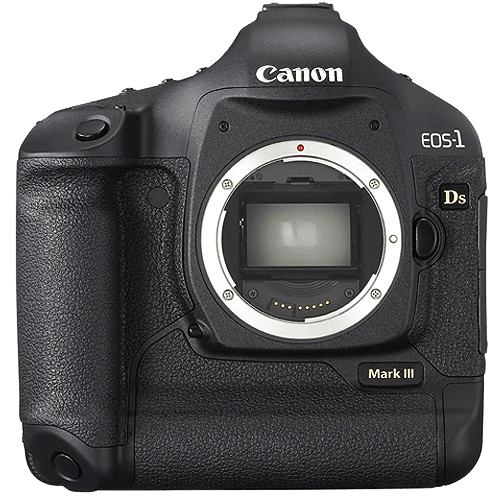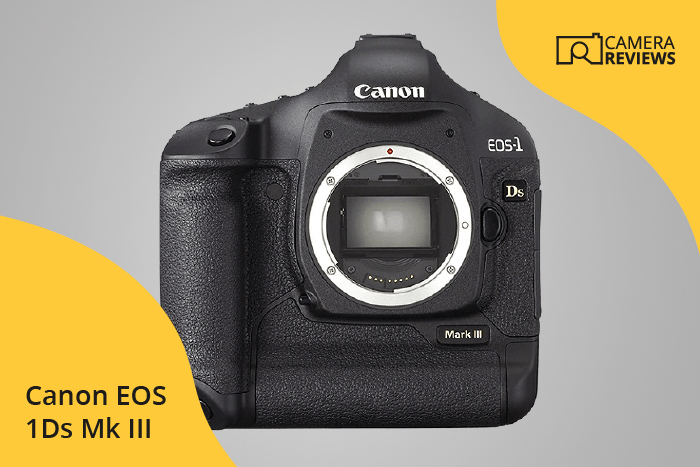Canon EOS 1Ds Mark III Specs and Scores

The Canon EOS 1Ds Mark III scores a solid 58/100 in our evaluation. Launched in 2007 at a price of $7100, this DSLR camera measures 150 x 160 x 80mm and weighs 1385g (3.05lbs). Considering its age and the rapid advancements in camera technology, the 1Ds Mark III still holds its own in today’s market. Its specifications remain relevant for enthusiasts and professionals, proving its durability and lasting appeal.
Canon EOS 1Ds Mark III Overview and Optics
The Canon EOS 1Ds Mark III receives a score of 60/100 for its optics. This camera features 21.1 megapixels, a shooting speed of 5, and a CMOS sensor. It uses a Digic III processor and has a DXOMARK sensor score of 80. The sensor size is full-frame, and the camera uses a Canon EF lens mount. However, it does not offer image stabilization, and its aspect ratio is 3:2.
Comparing these specifications to modern cameras, the 1Ds Mark III falls behind in some aspects. The absence of image stabilization can lead to less sharp images, especially in low-light conditions or when using longer focal lengths. Additionally, the shooting speed of 5 may be considered slow for action photography or capturing fast-moving subjects.
Despite these drawbacks, the full-frame sensor and 21.1 megapixels still allow for high-quality images. The Canon EF lens mount provides compatibility with a wide range of lenses, offering versatility in various shooting situations. Therefore, while the Canon EOS 1Ds Mark III might not be the top choice for those seeking the latest technology, it remains a reliable option for photographers who value image quality and lens compatibility.
Canon EOS 1Ds Mark III Video Performance
The Canon EOS 1Ds Mark III lacks video functionality. Unlike many modern cameras, it does not record video. This camera solely captures still images.
Canon EOS 1Ds Mark III Features and Benefits
The Canon EOS 1Ds Mark III holds a feature score of 49/100. This score reflects the camera’s capabilities and how it fares against other models in today’s market. The camera boasts a 3-inch screen with a resolution of 230,000 dots. However, it does not have a touchscreen or flip screen, which are common features in many modern cameras.
The EOS 1Ds Mark III lacks GPS and Bluetooth connectivity, but it does have WIFI capabilities. This allows users to transfer images wirelessly and control the camera remotely. Despite these features, the camera falls short in the competitive market due to its lack of modern specifications.
The Canon EOS 1Ds Mark III is a professional-grade camera with some useful features, but it struggles to compete with newer models that offer more advanced technology. Users may find the camera’s performance satisfactory, but for those seeking the latest features, other options may prove more suitable.
Canon EOS 1Ds Mark III Storage and Battery
The Canon EOS 1Ds Mark III earns a storage and battery score of 84/100, which is impressive. This camera boasts two memory card slots, accepting SD and Compact Flash (Type I or II) cards. This flexibility allows for ample storage options and easy file management.
Battery performance is also noteworthy, with the camera capable of capturing 1800 shots on a single charge. The LP-E4 battery type is reliable and long-lasting. However, the camera lacks USB charging, which may be inconvenient for some users.
Despite this minor drawback, the Canon EOS 1Ds Mark III remains a strong contender in today’s market, thanks to its excellent storage and battery capabilities.
Canon EOS 1Ds Mark III Alternatives
Do you want to know how the Canon EOS 1Ds Mark III compares to its competitors? Have a look at the most popular comparisons for this camera below:
- Canon EOS 1Ds Mark III vs Nikon D7500
- Canon EOS 1D Mark II N vs EOS 1Ds Mark III
- Canon EOS 1D Mark III vs EOS 1Ds Mark III
- Canon EOS 1D Mark IV vs EOS 1Ds Mark III
- Canon EOS 1D X Mark III vs EOS 1Ds Mark III
- Canon EOS 1Ds Mark III vs EOS 5D Mark III
Canon EOS 1Ds Mark III FAQ
Does the Canon EOS 1Ds Mark III Have Built-in Image Stabilization?
The Canon EOS 1Ds Mark III does not have built-in image stabilization. However, you can use lenses with image stabilization to reduce camera shake and achieve sharper images.
Does the Canon EOS 1Ds Mark III Support 4K Video Recording?
The Canon EOS 1Ds Mark III does not support 4K video recording, as it primarily focuses on still photography and lacks video functionality altogether.
What Size Sensor Does The Canon EOS 1Ds Mark III Have?
The Canon EOS 1Ds Mark III features a full-frame sensor, which measures 36 x 24 mm and provides excellent image quality and low light performance.
Does the Canon EOS 1Ds Mark III Have a Dual Memory Card Slot?
Yes, the Canon EOS 1Ds Mark III has a dual memory card slot, allowing you to use two memory cards simultaneously for greater storage capacity and backup options.
Does the Canon EOS 1Ds Mark III Have a Touch Screen?
No, the Canon EOS 1Ds Mark III does not have a touch screen. Instead, it relies on physical buttons and dials for menu navigation and settings adjustments.
Does the Canon EOS 1Ds Mark III Have Wi-Fi and Bluetooth?
The Canon EOS 1Ds Mark III has Wi-Fi capabilities for wireless image transfer and remote control, but it does not have built-in Bluetooth connectivity.
Does the Canon EOS 1Ds Mark III Have GPS?
No, the Canon EOS 1Ds Mark III does not have built-in GPS functionality. However, you can use an external GPS receiver to geotag your images.
Is the Canon EOS 1Ds Mark III Weather Sealed?
Yes, the Canon EOS 1Ds Mark III features weather sealing, making it resistant to dust and moisture. This allows you to shoot in various weather conditions with confidence.
Does the Canon EOS 1Ds Mark III Have a Built-in Flash?
No, the Canon EOS 1Ds Mark III does not have a built-in flash. You can use an external flash unit for additional lighting when needed.

